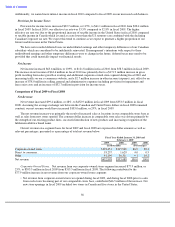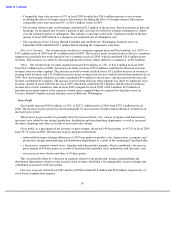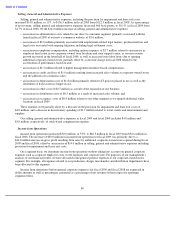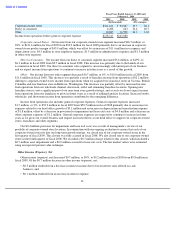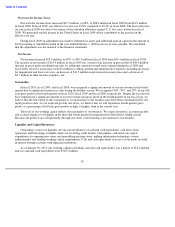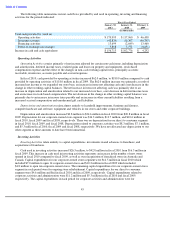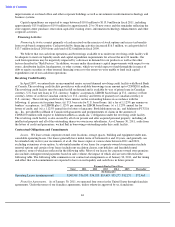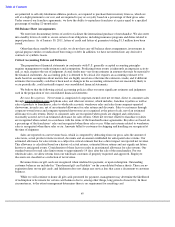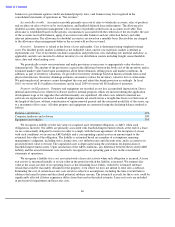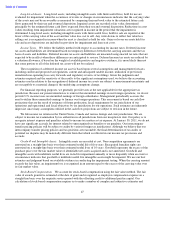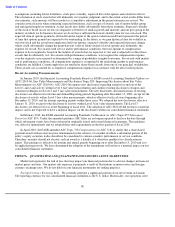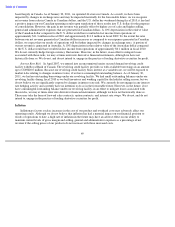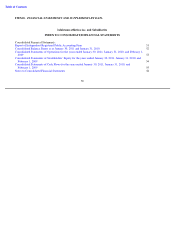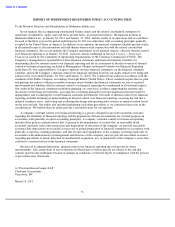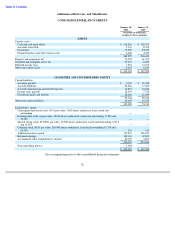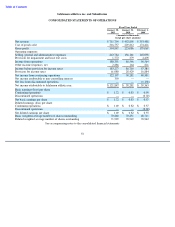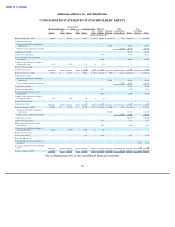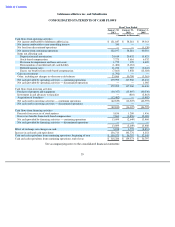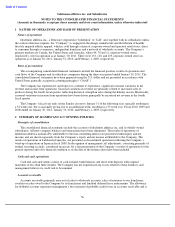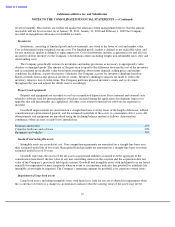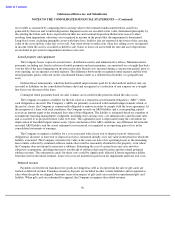Lululemon 2010 Annual Report Download - page 53
Download and view the complete annual report
Please find page 53 of the 2010 Lululemon annual report below. You can navigate through the pages in the report by either clicking on the pages listed below, or by using the keyword search tool below to find specific information within the annual report.
Table of Contents
assumptions, including future forfeitures, stock price volatility, expected life of the options and related tax effects.
The estimation of stock awards that will ultimately vest requires judgment, and to the extent actual results differ from
our estimates, such amounts will be recorded as a cumulative adjustment in the period estimates are revised. We
consider several factors when estimating expected forfeitures, such as types of awards, size of option holder group
and anticipated employee retention. Actual results may differ substantially from these estimates. Expected volatility
of the stock is based on our review of companies we believe of similar growth and maturity and our peer group in the
industry in which we do business because we do not have sufficient historical volatility data for our own stock. The
expected term of options granted is derived from the output of the option valuation model and represents the period
of time that options granted are expected to be outstanding. In the future, as we gain historical data for volatility in
our own stock and the actual term employees hold our options, expected volatility and expected term may change
which could substantially change the grant-date fair value of future awards of stock options and, ultimately, the
expense we record. For awards with service and/or performance conditions, the total amount of compensation
expense to be recognized is based on the number of awards that are expected to vest and is adjusted to reflect those
awards that do ultimately vest. For awards with performance conditions, we recognize the compensation expense
over the requisite service period as determined by a range of probability weighted outcomes. For awards with market
and or performance conditions, all compensation expense is recognized if the underlying market or performance
conditions are fulfilled. Certain employees are entitled to share-based awards from one of our principal stockholders.
These awards are accounted for as employee compensation expense in accordance with the above noted policies.
Recent Accounting Pronouncements
In January 2010, the Financial Accounting Standards Board (or FASB) issued Accounting Standards Update (or
ASU) 2010-06, Fair Value Measurements and Disclosures Topic 820: Improving Disclosures about Fair Value
Measurements (or ASU 2010-06). ASU 2010-06 requires new disclosures regarding transfers in and out of the
Level 1 and 2 and activity within Level 3 fair value measurements and clarifies existing disclosures of inputs and
valuation techniques for Level 2 and 3 fair value measurements. The new disclosures and clarifications of existing
disclosures are effective for interim and Annual Reporting periods beginning after December 15, 2009, except for the
disclosure of activity within Level 3 fair value measurements, which is effective for fiscal years beginning after
December 15, 2010, and for interim reporting periods within those years. We adopted the new disclosures effective
January 31, 2010, except for the disclosure of activity within Level 3 fair value measurements. The Level 3
disclosures are effective for us at the beginning of fiscal 2011. The adoption of ASU 2010-06 did not have a material
impact, and is not expected to have a material impact, on the disclosures within our consolidated financial statements.
In February 2010, the FASB amended Accounting Standards Codification (or ASC) Topic 855 Subsequent
Events
(or ASC 855). Under the amended guidance, SEC filers are no longer required to disclose the date through
which subsequent events have been evaluated in originally issued and revised financial statements. This guidance
was effective immediately and we adopted these new requirements in the first quarter of fiscal 2010.
In April 2010, the FASB amended ASC Topic 718 Compensation (or ASC 718) to clarify that a share-based
payment award with an exercise price denominated in the currency of a market in which a substantial portion of the
entity’s equity securities trades should not be considered to contain a market, performance or service condition.
Therefore, an entity should not classify such an award as a liability if it otherwise qualifies for classification in
equity. This guidance is effective for interim and annual periods beginning on or after December 15, 2010 and is to
be applied prospectively. We have determined the adoption of the amendment will not have a material impact on our
consolidated financial statements.
Market risk represents the risk of loss that may impact our financial position due to adverse changes in financial
market prices and rates. Our market risk exposure is primarily a result of fluctuations in interest rates and foreign
currency exchange rates. We do not hold or issue financial instruments for trading purposes.
Foreign Currency Exchange Risk. We currently generate a significant portion of our net revenue in Canada.
The reporting currency for our consolidated financial statements is the U.S. dollar. Historically, our operations were
48
ITEM 7A.
QUANTITATIVE AND QUALITATIVE DISCLOSURES ABOUT MARKET RISK


